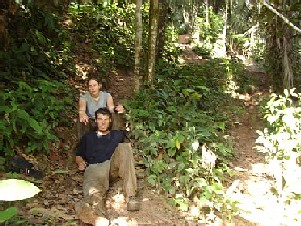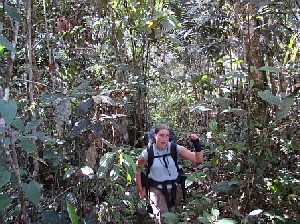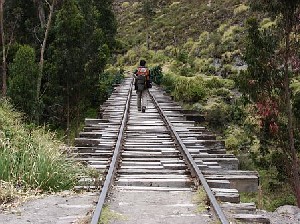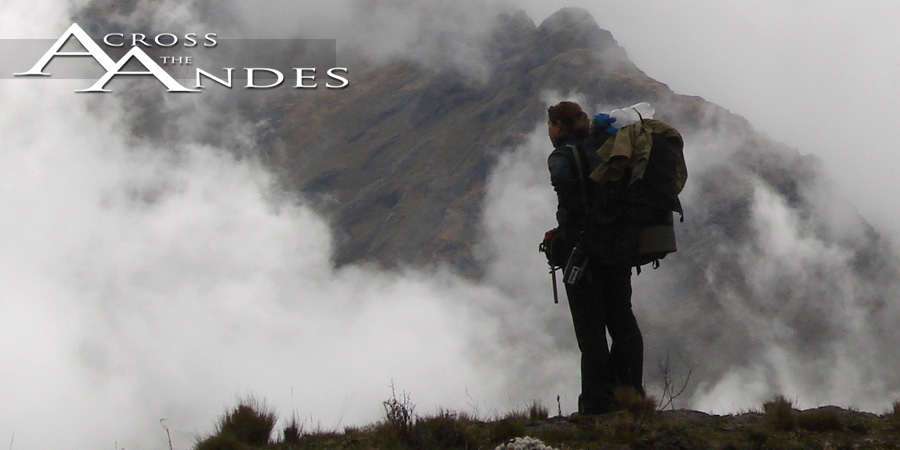Into the Selva
By Deia Schlosberg
August 6, 2006

Since our last installment, we experienced what seemed like the deepest depths of the Amazon rainforest, when in reality, we were only on the very outskirts of it. We were beckoned down in elevation and east in kilometers by a strong desire to experience monkeys and foot-long beetles and trees (just any trees, really) and brightly-colored birds and people living off the land and exotic fruits trailside and everything else that goes along with the idea of Jungle. We wanted to continue to diversify our experience and learn about the other side of the country. Ecuador is tiny but haltingly diverse. We did experience all of those things, but not nearly as romantically as they look strung together in a list. The jungle (selva) is also equally as characterized by mud, knee-deep, biting or stinging insects, humidity that the word itself doesn’t do justice, and maze-like rough machete-hewn trails that cannot be traveled without a guide, for navigation and permission reasons. But the jungle itself is remarkable and as alive a thing as exits probably anywhere in the universe. Every leaf, every twig, every stone has more life to be found on it than first glance reveals.
The chapter started in Arajunos, where the previous three days of solid imbibing for a local festival left the residents in sorry shape to explain the best route south through the jungle. Eventually one of them had the wherewithal to lead us to the city foundation president, who was actually sober. He was able to point us to a guide who could help us with our route and hopefully (it remained) teach us some important skills and bits of knowledge about living in the selva. Walter Canelos, of Canelos, would, in a very hazily-understood plan, lead us from Arajunos, through the core of the jungle, to Canelos, a route I assumed he had done before. Soon we were sprinting down a muddy path through thick vegetation after Walter, us with our huge packs and trekking poles and fancy hiking boots, and Walter in jeans and Keds. Up and down steep, thickly forested hills, sliding in mud, fording streams and rivers, dripping with sweat, covered in bites and stings, crawling over mossy, downed trees, dodging vines, always, we pressed after Walter, cruising tireless and dry just out of sight. Some time in there he told us he had never done this trek before. The 45km took us two very long, tiring days. We finished at Walter’s house in Canelos, where his family seemed to pity us immediately for the long, difficult walk with SuperWalter, as they showered us with niceness and soup and lemonade, all fresh from the selva. We were invited to stay for the night, so we gladly set up the tent, washed in the river, and spent a lovely evening and next morning of deluge-style rain in an amazingly beautiful home—half-walls of bamboo, thatched-roofs, dirt floors, chairs from stumps—very simple, but very comfortable, and all clearly allocated from the surrounding forest. The small garden gave us yuca (a potato-like tuber), caña (sugar cane), fruits, lemons, and the river just below gave us fish. The family was extremely kind and extremely generous, and standing under the thatched awning, overlooking the river with the rain pouring down and the green all around, I felt very happy. It seemed that here, living was done right.

We left Canelos for Macas, determined to cover some real miles. We were, however, immediately distracted from our goal when the first afternoon we were invited by Segundo and Rosa to stop in at their home for a rest. Slaves to cultural enrichment, we accepted. Their “home” turned out to be where they worked, an ecotourism resort of sorts, a lovely jungle retreat called Everybody’s Jungle, with several thatched-roof buildings of dormitories on stilts, ponds, gardens, and an impressive central lodge complete with a bar, airplane seats, and posters and National Geographics lining the walls. The intent was to stop in for a quick drink and then keep walking with the remaining daylight. Gregg and I were both so stuck by the place, however, that the first dorm room over the river ended up being ours for the night, as well as a dinner of freshly-caught (rather, awkwardly-netted in front of us from the ponds) tilapia and rice and veggies, and half a bottle of whisky to top it off (the other half was consumed by Guido, the owner, Segundo and Rosa). The next day we were back in the thick of the jungle again, following a guide over narrow, muddy trails, though this time because we weren’t allowed through the privately-owned reserve without one. We even got to cross a river in a hollowed-out canoe, which we nearly tipped every 2 seconds. After parting with our guide (much more humanly-paced than Walter), we soon ran into José and Adleine. A French volunteer with the community of Santa Ana, Adleine informed us of the volunteer program there and the water-purification project going on, and told us where to go to learn more about it. The desire to continue south dropped to second place behind wanting to learn more about how a community functions under the influence of aide and how the water project would affect the people there. Hence, we decided to offer our services, of any helpful sort, in exchange for some food for a few days. When we spoke with Rebecca, the founder of the community, about our proposal, we were surprised to learn that each volunteer there, about ten of them, paid a daily food charge of four dollars. Food in the selva costs in the neighborhood of $1 dollar a day. Each volunteer stays for a month or two on average. That’s $1200 a month to the community in exchange for having volunteers help with their projects. It seemed odd to me. The community wasn’t struggling, the people were fairly healthy, and in fact, they were some of the most capable people I’ve ever encountered. Wilo, Rebecca’s son-in-law, whom we stayed with, was probably the most productive human I’ve ever met. He finished more projects (he’s a carpenter) in the few days we were there than most people start in their lives. My point is, I just really didn’t get the aide piece. Why this community? It seemed that their only problem, as I would call it, was that they were becoming too dependant on resources from town, necessitating a weekly bus ride to restock, when the jungle was able to provide nearly everything they needed. Rebecca, being one of the few people in town to have a kitchen garden, expressed this frustration at one point, saying that her original view of the community was nothing like it had turned out. The water project gave more questions than answers as well. Would having clean drinking water in their homes eliminate the people´s acquired immunity to the bacteria in the water? Would this project end up making more people sick than before? I really don’t know; I spent only a few days in Santa Ana. But I definitely left the place wondering, and a little bit disillusioned. And kind of ironically, pretty darn sick myself. However, the kindness of Rebecca, Wilo and others is by no means tied to my mixed feelings of the outcomes of aide.

With the jungle craving satiated for what will probably be a good while, we returned home to the mountains. In the last couple of days we’ve been covering some ground, most recently following the railroad tracks of the famed Devil’s Nose train south through Guamote. We hope to be in Cuenca in a week, where we’ll visit Gregg’s good friend from the trail, Coyote, who’s currently doing a Peace Corps stint there.
Thanks for all of your comments and emails. It’s great to hear from folks and we think of you all often from down here under the southern stars.







